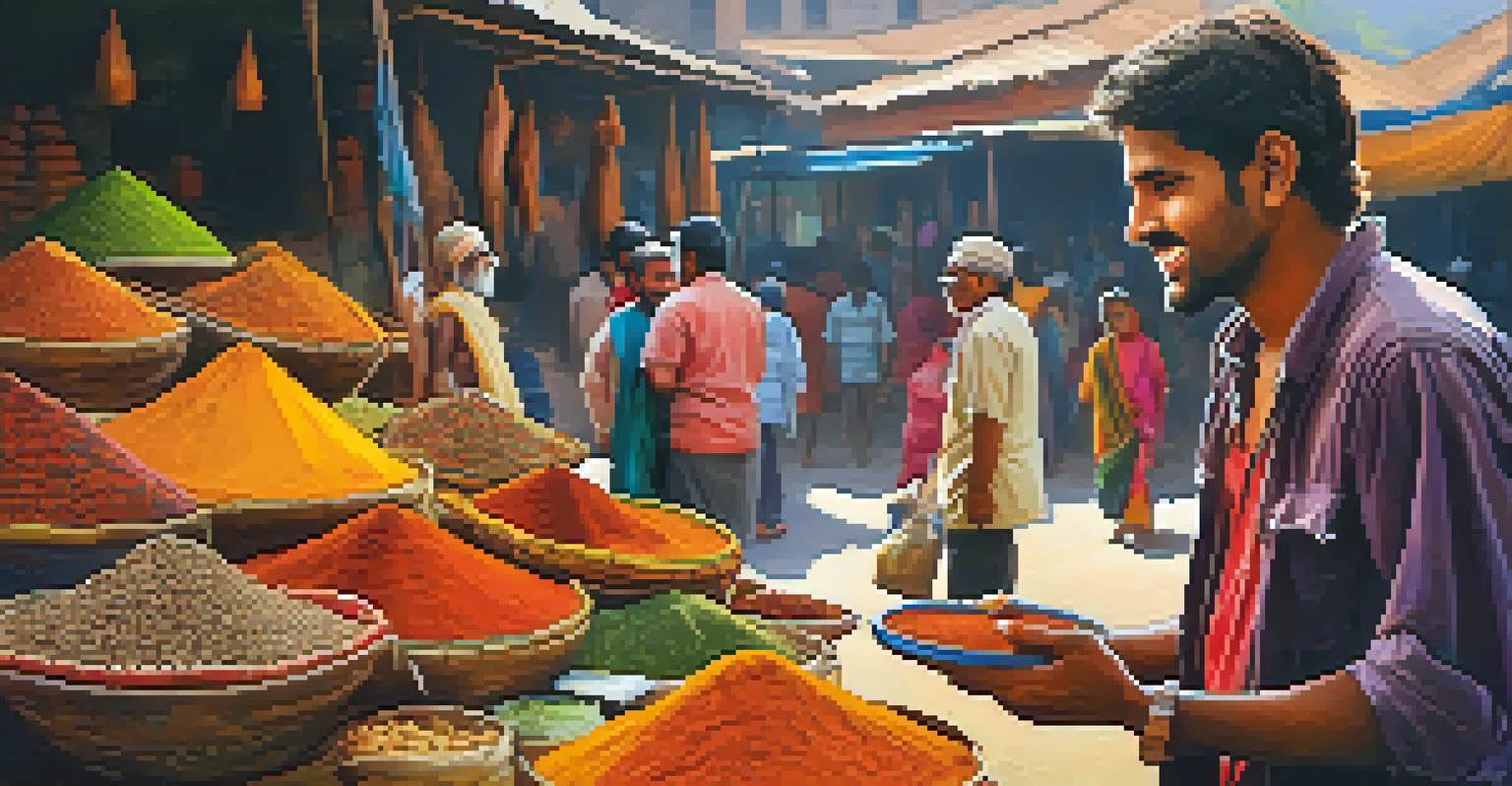Cultural Etiquette for Backpackers Traveling in India

Understanding the Importance of Namaste in Greetings
In India, greetings are not just formalities; they hold deep cultural significance. The gesture of 'Namaste,' which involves pressing your palms together and bowing slightly, conveys respect and acknowledgment. This simple act is a beautiful way to connect with locals, transcending verbal communication.
Traveling – it leaves you speechless, then turns you into a storyteller.
Using 'Namaste' instead of a handshake is particularly important, especially when greeting elders or in rural areas. It shows your understanding of Indian customs and creates a favorable impression. Just remember, the intention behind the greeting matters more than perfection.
By embracing 'Namaste,' you not only respect local traditions but also open doors to more meaningful interactions. So, next time you meet someone in India, don’t hesitate to incorporate this heartfelt gesture into your greeting repertoire.
Dress Modestly to Show Respect for Local Customs
India is known for its rich tapestry of cultures, and attire can vary significantly across regions. As a backpacker, wearing modest clothing—like long skirts or trousers and tops with sleeves—helps you blend in and shows respect for local customs. This is especially important when visiting religious sites or rural areas.

While vibrant colors are celebrated in India, it's advisable to avoid overly revealing outfits. Modesty is valued, and dressing appropriately can prevent unwanted attention and misunderstandings. Think of it as a way to honor the local way of life while enjoying your travels.
Embrace Namaste for Respectful Greetings
Using 'Namaste' instead of a handshake shows respect for Indian customs and fosters meaningful connections.
Ultimately, dressing modestly not only keeps you respectful but also enhances your experience by allowing you to connect more genuinely with the culture. Plus, it’s a great excuse to explore the beautiful traditional attire available in local markets!
Dining Etiquette: Eating with Hands and Sharing Food
In India, meals are often a communal experience, reflecting the spirit of hospitality. Eating with your hands is not just common; it's an art that signifies connection to the food. The practice is typically done with the right hand, as the left is considered impolite for eating.
The journey not the arrival matters.
If you're invited to someone's home, don’t be surprised if you're offered food to share. Accepting food graciously is key to showing respect and appreciation. Remember, it's customary to finish what's on your plate as a sign that you enjoyed the meal, so take only what you can eat.
By embracing these dining customs, you’ll find that sharing meals can lead to unforgettable interactions and stories. It’s a wonderful way to immerse yourself in the local culture and appreciate the flavors of India.
Respecting Religious Practices and Traditions
India is a land of diverse religions, each with its own unique practices. As a traveler, it’s crucial to approach religious sites with reverence. Whether you're visiting temples, mosques, or churches, be mindful of the customs, such as removing your shoes or dressing appropriately.
When photographing religious ceremonies or rituals, always ask for permission first. Some devotees may prefer to keep their practices private, and respecting their wishes is paramount. This sensitivity not only honors their beliefs but also enhances your experience.
Dress Modestly to Honor Local Culture
Wearing modest attire helps you blend in and demonstrates respect for the diverse customs in India.
Observing and learning about these practices can deepen your understanding of India's rich cultural landscape. It transforms your journey from mere sightseeing to a heartfelt exploration of traditions that have shaped the nation.
Bargaining: The Art of Negotiation in Markets
In bustling markets across India, bargaining is not just common; it's expected. When shopping for souvenirs or local goods, haggling can be a fun and engaging part of the experience. It’s a way to connect with vendors, who often enjoy the interaction as much as the sale.
Start by offering a price lower than what you’re willing to pay, and be prepared to negotiate. Remember, it’s all in good spirit, and a smile can go a long way in making the exchange pleasant. If the vendor is not willing to negotiate, it's perfectly fine to walk away.
Mastering the art of bargaining not only helps you save money but also adds a layer of excitement to your shopping adventures. Plus, you'll leave with stories to tell and perhaps even a newfound friendship with a local vendor.
Understanding the Concept of Personal Space
In India, the concept of personal space differs significantly from what many Westerners are accustomed to. Crowded streets and public transport mean that physical proximity is often unavoidable. As a backpacker, it's essential to adapt to this norm while being mindful of the comfort levels of others.
When interacting with locals, be aware that touching, especially between opposite genders, may be seen as inappropriate unless you have established a rapport. It's important to gauge body language and follow the lead of those around you.
Learn Local Language for Better Connections
Making an effort to learn a few local phrases can enhance interactions and show appreciation for the culture.
By understanding these nuances, you'll navigate social situations with ease and respect. Embracing the local perspective on personal space can enhance your interactions and allow you to engage more deeply with the culture.
Using Local Language: A Key to Meaningful Connections
While English is widely spoken in India, making an effort to learn a few local phrases can go a long way. Simple words like 'please,' 'thank you,' and greetings in Hindi or the regional language can break the ice and demonstrate your respect for the culture.
Locals often appreciate when travelers try to communicate in their language, and it can lead to warmer interactions. You might even find that speaking a few words opens up conversations and invites stories about their lives and traditions.

This small investment in learning can transform your travel experience from being a mere observer to an engaged participant in the local culture. So, don’t shy away from picking up a few phrases during your journey!
Navigating Public Transportation with Caution
India’s public transportation system is vast and varied, offering everything from buses to trains. While it can be an adventure, it’s important to approach it with caution and awareness of local norms. For instance, during peak hours, expect crowded conditions, and be prepared for some jostling.
When using local transport, always be vigilant about your belongings. Petty theft can occur, especially in crowded areas, so keep your valuables secure and avoid displaying expensive items. It’s wise to travel light and keep essential documents close.
Embracing public transport not only saves money but also immerses you in the local lifestyle. It's a chance to meet people and experience the daily rhythm of life in India, making your backpacking journey even more memorable.